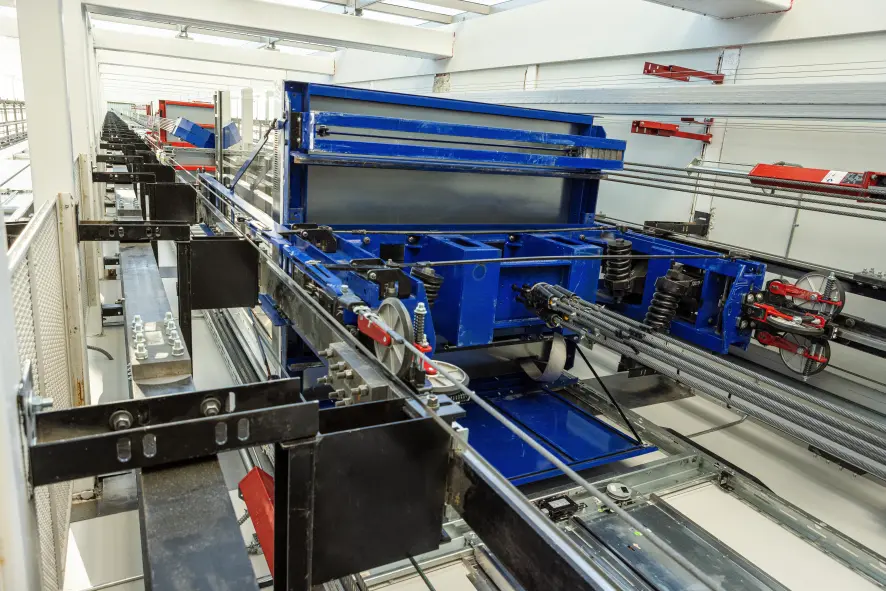Can Two Elevators in One Shaft Collide? And 5 Other TWIN Questions Answered
In some elevators, you have to sift through the specs to see what makes them unique. But TWIN makes it easy to see: two elevator cars running independently in one hoistway. TWIN is the world’s first elevator system of its kind, and it’s breaking down barriers. But there's one question everyone asks: how can two elevators function independently in one shaft?
Although it’s already installed in numerous cities worldwide, most commuters don’t know much about the technology that carries them to their destination floors. If you live in a crowded metropolitan area, you might have ridden a TWIN elevator without even knowing it.
This article will tackle your biggest questions about TWIN. Let’s dive in!

Can Two Elevators in One Shaft Collide?
You can see TWIN in action at our Innovation and Qualification Center in Atlanta; floor-to-ceiling windows give you a view directly into two TWIN hoistways with a total of four cabs. The bottom elevator serves the lower floors while the top goes all the way up to the 27th floor.
So, do these elevators ever run into one another?
The short answer is no, the cabs absolutely cannot collide. A monitoring system ensures that a minimum distance between the two cabs is observed. If this distance were ever to be breached, an emergency stop system immediately turns off the elevator drives, and that in turn activates the emergency brakes in the TWIN cabs.
Has TWIN Been Certified by Any Safety Experts?
Yes! This elevator system is classified at Safety Integrity Level 3 (SIL3), the highest classification possible, and this is due mostly to its independent control system.
The system constantly monitors the distance between the two cabs. You can rest assured that you are safe and sound inside either one of the cabs.
How Do the Elevators Know To Avoid Each Other?
Constant monitoring is a good start. It’s extremely rare that both cabs would ever get close enough to activate the emergency shut-off. Elevators are smart, and the controller (the brain of the elevator) knows to avoid this at all costs.
TWIN also comes equipped with a destination dispatch integration called AGILE. This digital solution gauges traffic demand and groups passengers together based on the floor they are heading to. Typically, its primary purpose is to increase efficiency and reduce wait times. When installed in TWIN, monitor which groups are going to which floors and when to send them to another cab. This acts as another precaution to ensure that the minimum safety distance is respected.
What Is the Main Benefit of Two Elevators in One Shaft?
Like any vertical transportation innovation, TWIN was developed after we saw a need for better traffic flow. Large buildings and properties frequently face the hardship of having too few elevators for the large number of commuters that pass through. To combat that issue, the idea of two elevator cars working independently in one hoistway was born.
TWIN can move people twice as fast and transport up to 40% more passengers in the same amount of time. The two cabs also reduce the number of shafts and floor entrance openings, which increases the usable building space so building owners can save money. Destination dispatch was also installed to group riders together and shorten wait times in the lobby areas. While there is seemingly no limit to the benefits of TWIN, the main benefit is decreased lobby congestion and happier passengers.
Is TWIN Less Energy Efficient because of the Two Cabs?
Each industry is trying to do their part in creating a more sustainable future. TK Elevator is no different. You might intuitively assume that TWIN uses more energy because of the separate cabs, but this is incorrect.
TWIN is ready to take on the world of high-rise buildings as an energy-efficient elevator solution. It comes equipped with our regenerative drive, so unused energy can be fed back into your building grid, resulting in the system needing less power. Also, if passenger volume is low for the time being, TWIN will park one cab while the other stays in operation to save as much energy as possible.
Can TWIN Be Installed in a Building That Already Has an Elevator System?
Yes, TWIN can be installed in a building that already has an elevator system in place. The great thing about this product is that it can be installed as part of a modernization project. There’s no need to bulldoze part of your building to create room for it, we will just add another cab and hoisting equipment to your existing shaft! Then you can start moving more passengers without having to start all over on building construction. It’s a double win.
Visit our TWIN product page to learn more about this novel system. Our local branches can help you determine whether or not TWIN is a good fit for your building.
 United States
United States

